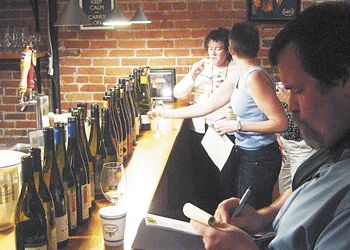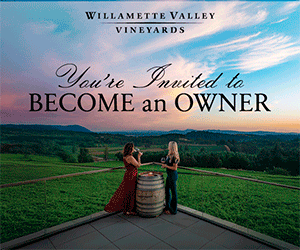Resurgence in Riesling

By Karl Klooster
When wine pioneer Richard Sommer planted Oregon’s first modern-era vineyard just outside Roseburg in the early 1960s, he gave special consideration to white Riesling.
A fan of the grape responsible for the great wines from Germany’s Rhine, Mosel and Nahe regions, he felt it was likely the cool-climate variety would do well at his Umpqua Valley location.
As it turned out, the Rieslings produced by Sommer proved to be lush, lively and long-lived. They were closely akin to the sensuous, seductive style for which the finest individual vineyards of the Rheingau have become world-renowned.
With Pinot Noir’s ascendancy, however, interest in Riesling waned. Oregon growers gravitated toward Chardonnay, postulating that if Pinot could be so successful, the same might be true for its white counterpart.
The rapidly rising popularity of Pinot Gris contributed further to Riesling’s stagnation. As a fruit-forward, immediately drinkable wine, Gris offered wineries an attractive, reasonably priced option that generated quick cash flow.
Still, the challenge of capturing white Riesling’s distinctive character continued to entice winemakers. After all, it was not without reason that the variety had earned such a stellar international reputation.
A long, cool growing season, low yields and ideally suited soils spoke to Riesling’s potential, particularly in the northwestern part of the state. It prompted a group of wineries to form the Oregon Riesling Alliance, which now counts 38 members.
The increase in Oregon Riesling plantings, from a low of 551 acres in 2002 to 741 acres currently, is due in great measure to the group’s efforts. The Columbia River Gorge leads the way with 156 acres, followed by Yamhill County with 121 and Marion County with 100.
Members are also adopting the International Riesling Foundation’s sweetness scale, a back label graph that clearly indicates the wine’s sweetness level — dry, medium-dry, medium-sweet or sweet — to potential buyers.
Championing Riesling has led members to focus a more concerted effort on the grape, and with gratifying results.
Alliance members presented the opportunity to sample just how satisfying their efforts have been during a recent tasting at Nick’s Italian Café in McMinnville. On Sunday, June 25, the bar in the backroom of Nick’s was lined with more than two dozen Oregon Rieslings, alphabetically arranged from left to right in three groups by levels of residual sugar.
The site of many a storied event over the years, Nick’s backroom has achieved near legendary status in the Oregon wine industry. And this tasting certainly served to augment that well-deserved reputation.
Predictably, individual preferences varied among the experienced tasters in attendance. But the consensus was the collection featured mostly floral, fruit-driven wines balanced by bright acidity.
And then there was the uniquely Oregon element.
Certain distinctive characteristics are common to many Oregon Rieslings when they are smelled and tasted, but apt descriptors seem somewhat elusive. Chehalem owner Harry Peterson-Nedry likens it to an all-in-one acidity and minerality component.
There is general agreement that retention of fruit in a fully dry Riesling — 1 percent or less of residual sugar — tests the mettle of any winemaker. Among the wines on hand, the dry styles most prominently exhibited this Oregon identity.
My personal favorites included the Chehalem Reserve, Lemelson Willamette Valley and Penner-Ash Willamette Valley. All were 2008s of very limited production — 438, 403 and 271 cases, respectively.
Lack of offsetting residual sugar can lead to an acrid taste in a light-bodied white. But floral, citrusy aromas and focused fruit carried the day for these.
My tasting notes included comments such as “purity, richness and balance, even though bone dry.”
In the sweet group — 1.5 percent to 6 percent residual sugar — the Brooks Sweet P, Elk Cove Estate and Trisaetum Willamette Valley, all from 2008 as well, stood out.
Nuanced floral, mineral and citrus notes accented the Brooks, which came in at 5.1 percent residual sugar. While at only 1.83 percent residual sugar, the Elk Cove exhibited a lip-smacking fresh-fruit concentration and lively acidity.
Perhaps the most alluring of this trio was the Trisaetum, wherein rich and complex flavor interactions surround a nutty, sweet caramel core.
Completing the three-part tasting were late-harvest dessert wines in de rigeur 375-milliliter bottles. The 2007 Amity Late Harvest stood out for its combination of lush fruit and zingy citrus, balanced by sturdy acidity that suggested laying away for a while.
Oregon dry Riesling remains a quality-to-price bargain, at least for the time being.
One of its least appreciated attributes is the ability to age, which examples from pioneer winemaker Myron Redford have shown time and time again. He repeatedly pulls charmingly complex dry Rieslings, a decade or more old, from his Amity Vineyards cellar.
Riesling lovers point to vineyards clinging to the steep, terraced banks of the Mosel River and its tributaries, the Saar and Ruwer, as the quintessence of what the grape can achieve.
Although it may not be possible to replicate Mosel Rieslings, with their intensely crisp, green-apple acidity and seductively stony minerality from soils composed of slate and quartzite, a uniquely appealing Oregon profile seems to be evolving.
Softly textured, yet lively in mouthfeel, the taste profile can emphasize apple, spice or stone fruit as well as varying combinations. Most of all, the fruit has a freshness and purity that winemakers revel in achieving.
Given Riesling’s diversity, as both a delightful stand-alone sipper and an excellent match for a wide range of lighter dishes, it deserves greater attention from local winemakers and appreciation by consumers everywhere.
OREGON RIESLING ALLIANCE
A to Z Wineworks, Airlie Winery, Amity Vineyards, Ana Vineyards, Anam Cara Cellars, Anne Amie Vineyards, Argyle Winery, August Cellars, Belle Pente Vineyard, Bergström Wines, Brandborg Vineyard, Bridgeview Winery, Brooks Wines, Chehalem, Daedalus Cellars, Elk Cove Vineyards, Hawks View Cellars, Holloran Vineyard, J. Christopher, Kings Ridge, Lemelson, Love & Squalor, Marks Ridge Winery, Matello Winery, Montinore Estate, Penner-Ash Wine Cellars, Ponzi Vineyards, Ransom Cellars, Retour, Roots Wine Co., Siltstone Wines, Sineann Wines, Soléna Estate, Sweet Cheeks Winery, Trisaetum, Vitae Springs Vineyard, Viento, Willamette Valley Vineyards, Wine Country Farm.












